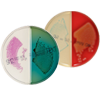Gastrointestinal Infections
- > 200 million episodes/year of infectious gastroenteritis in US1
- Worldwide 3-6 million children die each year from infectious gastroenteritis2
- Outbreaks of gastrointestinal infections are a serious concern in the hospital environment
Definition
Gastrointestinal infections are viral, bacterial or parasitic infections that cause gastroenteritis, an inflammation of the gastrointestinal tract involving both the stomach and the small intestine. Symptoms include diarrhea, vomiting, and abdominal pain. Dehydration is the main danger of gastrointestinal infections, so rehydration is important, but most gastrointestinal infections are self-limited and resolve within a few days. However, in a healthcare setting and in specific populations (newborns/infants, immunocompromized patients or elderly populations), they are potentially serious. Rapid diagnosis, appropriate treatment and infection control measures are therefore particularly important in these contexts.
Gastrointestinal infections can be caused by a large number of microorganisms, including:
Adenovirus
Adenovirus can cause diarrhea, fever, conjunctivitis, bladder infections and rashes, but the most common symptom is respiratory illness. After rotavirus, it is the most common cause of pediatric diarrhea.
Campylobacter
Campylobacter is one of the most common bacterial cause of gastroenteritis worldwide and is frequent in children under two. It can cause diarrhea (sometimes bloody), abdominal cramps, vomiting and fever. It is usually food-borne through raw or undercooked meat (especially poultry) or through contaminated milk.
Clostridium difficile
Clostridium difficile infection is responsible for up to 25% of cases of antibiotic-associated diarrhea most often contracted in hospitals or healthcare institutions3. Elderly and immunocompromized patients are most at risk. The recent emergence of highly toxigenic and resistant C. difficile strains has led to more frequent and severe outbreaks, increased morbidity and mortality.
Escherichia coli
Escherichia coli, often called E. coli, is the leading cause of travelers’ diarrhea and a major cause of diarrheal disease in the developing world, especially among children. People usually contract E. coli through ingestion of water contaminated with human or animal feces.
Escherichia coli O157:H7
Escherichia coli O157:H7 is a Shiga toxin-producing form of E. coli bacteria, which causes gastrointestinal infections with symptoms including bloody diarrhea and vomiting. Though it usually resolves after a few days, it can sometimes (5-10%4 of infections) lead to hemolytic uremic syndrome (HUS), which can result in kidney failure if untreated.
Helicobacter pylori
Helicobacter pylori, called H. pylori, is a cause of gastritis and is associated with the development of gastric and duodenal ulcers. It can cause stomach pain or nausea, but in many cases there are no symptoms. Infected people have a 10-20% lifetime risk of developing peptic ulcers and a 1 to 2% risk of stomach cancer5.
Rotavirus
Rotavirus is the most frequent cause of diarrhea in young children and infants and it is responsible for the most severe cases. There is a vaccine for rotavirus, but globally it causes more than ½ million deaths per year in children less than five years old.6 Most of these are in emerging countries.
Salmonella and Shigella
Salmonella and Shigella are food-borne GI illnesses. Salmonella is common and is found in raw meats, poultry, seafood and eggs, as well as milk and dairy products. Acute symptoms include nausea, vomiting, abdominal cramps, diarrhea, fever, and headache. Shigella is frequently found in water polluted with human feces. Symptoms of shigellosis (bacillary dysentery) include abdominal pain, cramps, diarrhea, fever, vomiting, and blood, pus, or mucus in stool.
Staphylococcus aureus
Staphylococcus aureus is the most common cause of food intoxication, characterized by abrupt/violent onset, severe nausea, cramps, vomiting, and diarrhea using lasting 1-2 days. This opportunistic pathogen can be found on humans (skin, infected cuts, noses and throats) and has been associated with a wide range of foods including meat and meat products, poultry and egg products, salads, bakery products, and dairy products.
Yersinia enterocolitica
Yersinia enterocolitica, called Y. enterocolitica, is a relatively infrequent cause of diarrhea and abdominal pain. Infection is most often acquired by eating contaminated food, especially raw or undercooked pork products, as well as ice-cream and milk. Common symptoms are fever, abdominal pain, and diarrhea, which is often bloody.
Diagnosis
When symptoms point to a possible gastrointestinal infection, diagnosis can be confirmed through laboratory tests used for culture or antigen detection from stool specimens. In certain cases (e.g. for E. coli, Salmonella, C. difficile …), antibiotic susceptibility testing is used to determine microbial resistance to antibiotic therapy, if appropriate. Particularly in hospital settings, rapid diagnosis provides important information for implementing infection control measures.
To diagnose the cause of a diarrhea, it is helpful to consider where the context is a food-borne outbreak or “travelers’ diarrhea”.
Food-borne outbreaks:
- Often local – a group of people eating together suffer the same illness.
- A public health concern when widespread, affecting people in different places and over a longer period of time.
- Important to recognize and track epidemiologically, to prevent more people from being infected.
- E. coli, Salmonella, Campylobacter and Staphylococcus are among the most common pathogens causing food-borne outbreaks.
Travelers’ diarrhea:
- Most common travel-related illness.
- Contracted by people travelling in places where there are different pathogens from what they are used to, especially in regions where food/water contamination is more prevalent.
- Most commonly transmitted through ingestion of food or water contaminated with feces.
- Most cases caused by bacteria including E. coli, Salmonella and Shigella.
Prevention / Treatment
The best ways to prevent gastrointestinal infection include:
- Proper hand-washing
- Disinfecting of contaminated surfaces with bleach
- Washing of soiled articles of clothing
- Identifying infected patients as soon as possible to implement extended infection control
- There are no vaccines for most gastrointestinal infections. Exceptions:
- Rotavirus
- Adenovirus (limited availability)
- For C. difficile: avoid prescribing antibiotics unnecessarily
Treatment measures for gastrointestinal infection include:
- Rehydration – oral and sometimes intravenous
- For many cases of bacterial gastroenteritis, only symptomatic treatment (for fever, diarrhea…) is required.
- Antibiotics are not usually recommended as they have no effect on viral infections, may cause side effects and overuse increases the risk of resistant bacteria developing.
- Antibiotics may be recommended in particularly severe cases of gastroenteritis, or if a specific bacteria has been identified as the cause.
Guidelines
- Infectious Diseases Society of America (IDSA)
Practice Guidelines for the Management of Infectious Diarrhea. Clinical Infectious Diseases 2001; 32:331–50
http://cid.oxfordjournals.org/content/32/3/331.full Update in progress for 2014. - World Gastroenterology Organisation
Practice guideline: Acute diarrhea (LINK: http://www.worldgastroenterology.org/assets/downloads/en/pdf/guidelines/01_acute_diarrhea.pdf)
- Society for Healthcare Epidemiology of America (SHEA) / Infectious Diseases Society of America (IDSA)
Clinical Practice Guidelines for Clostridium difficile Infection in Adults: 2010 Update by SHEA / IDSA Infect. Control Hosp. Epidemiol. 2010;31(5):000-000
http://www.jstor.org/stable/10.1086/651706
- World Health Organization
Manual of rotavirus detection and characterization methods [PDF-3.8MB, 156 pages]. 2009. IVB/08.17.
http://whqlibdoc.who.int/hq/2008/WHO_IVB_08.17_eng.pdf
- U.S. Department of Health and Human Services Centers for Disease Control and Prevention (CDC)
Guidelines for Environmental Infection Control in Health-Care Facilities
http://www.cdc.gov/hicpac/pdf/guidelines/eic_in_HCF_03.pdf
REFERENCES
- Bryan CS. Infectious Diseases in Primary Care. Edition: Saunders. 2002
- Merck Online Medical Library – Gastrointestinal Disorders www.merck.com
- Bartlett JG. Clinical practice. Antibiotic-associated diarrhea. N Engl J Med 2002;346:334-349
- CDC website: http://www.cdc.gov/ecoli/
- Clin Microbiol Rev. 2006 July; 19(3): 449–490. doi: 10.1128/CMR.00054-05
“Pathogenesis of Helicobacter pylori Infection”, Johannes G. Kusters, Arnoud H. M. van Vliet, and Ernst J. Kuipers http://www.ncbi.nlm.nih.gov/pmc/articles/PMC1539101/ - CDC website: http://www.cdc.gov/rotavirus/index.html
Az oldal tartalma nem tekinthető orvosi tanácsnak
Az oldal egészségügyi tartalma összefoglaló formában jelenik meg, jellegét tekintve általános, és csak tájékoztatásra szolgál. Az oldal szerzőinek nem állt szándékában és nem is ajánlatos a tartalmat professzionális orvosi tanács helyett használni. Az oldal egészségügyi tartalmát nem szabad egészségügyi vagy közérzeti probléma vagy betegség diagnosztizálására használni. Mindig kérjen tanácsot orvosától vagy más egészségügyi szakembertől bármilyen egészségügyi problémával vagy kezeléssel kapcsolatban. Az oldal semmilyen tartalmát sem szánták orvosi diagnózisnak vagy kezelésnek. Orvosok nem használhatják fel egyedüli forrásként a felírandó gyógyszert érintő döntésekhez. Soha ne hagyja figyelmen kívül az orvosi tanácsot, illetve ne halogassa, hogy orvoshoz menjen olyasmi miatt, amit ezen az oldalon olvasott.






